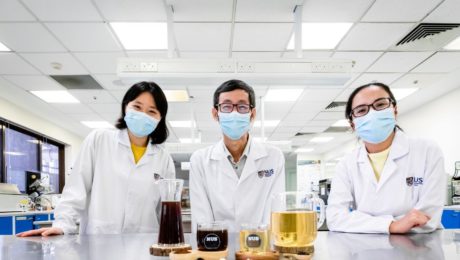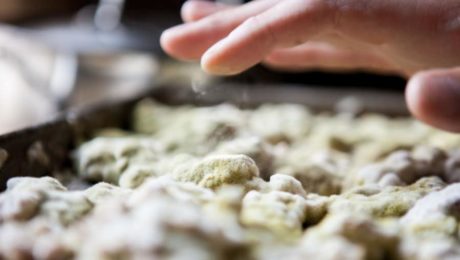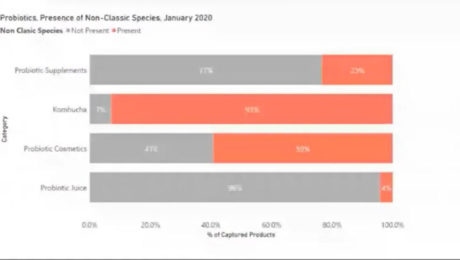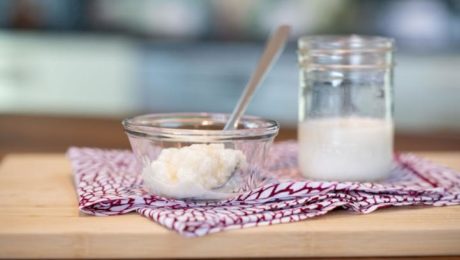New Fermented Coffee & Tea Drinks
Researchers from the National University of Singapore (NUS) have created new fermented coffee and tea drinks. These drinks, invented by a professor and two doctoral students, are being labeled as “probiotic coffee and tea drinks that are packed with gut-friendly live probiotics.” They claim that the drinks can be stored for three months without altering the probiotics.
“Coffee and tea are two of the most popular drinks around the world, and are both plant-based infusions. As such, they act as a perfect vehicle for carrying and delivering probiotics to consumers. Most commercially available probiotic coffee and tea drinks are unfermented. Our team has created a new range of these beverages using the fermentation process as it produces healthy compounds that improve nutrient digestibility while retaining the health benefits associated with coffee and tea,” explained NUS Associate Professor Liu Shao Quan.
Read more (Science Daily)
Does Geography Matter for Sourdough Flavor?
Results of the first large-scale study of sourdough starters were released last week — and the conclusions are fascinating, challenging myths about sourdough. Scientists from four different universities studied 500 sourdough starters from four continents, with an aim to determine microbial diversity.
“We didn’t just look at which microbes were growing in each starter,” says Erin McKenney, co-author of the paper and an assistant professor of applied ecology at North Carolina State University. “We looked at what those microbes are doing, and how those microbes coexist with each other.”
The most striking finding: geography doesn’t matter.
Sourdough enthusiasts preach that location and climate will alter sourdough flavor. San Francisco has long held bragging rights for the most distinctive taste profile. But, of the 500 samples, there was little evidence of geographic patterns.
“This is the first map of what the microbial diversity of sourdoughs looks like at this scale, spanning multiple continents,” says Elizabeth Landis, co-lead author of the study and a PhD student at Tufts. “And we found that where the baker lives was not an important factor in the microbiology of sourdough starters.”
Alex Corsini, CEO and founder of sourdough pizza brand Alex’s Awesome Sourdough (and TFA advisory board member), says the research “demystifies the misconception that sourdough is only good in certain pockets of the world such as San Francisco.” Great sourdough, he says, is about the raw materials.
“It further shows why sourdough is ubiquitous all over the world — starters can thrive anywhere as nature provides the magic and bakers just need to be in a position to coax out a result without ruining the magic — the magic here being the microbial balance needed to ferment and levain baked goods,” Corsini says.
The research also found there is no one single variable responsible for sourdough variations, bucking conventional baking wisdom.
“What we found instead was that lots of variables had small effects that, when added together, could make a big difference,” says Angela Oliverio, co-lead author of the study and a former PhD student at the University of Colorado, Boulder. “We’re talking about things like how old the sourdough starter is, how often it’s fed, where people store it in their homes, and so on.”
As a commercial sourdough producer, Corsini values the “low and slow” process to master a sourdough batch, especially when making it consistently on a large scale. Alex’s Awesome Sourdough undergoes a 70-hour ferment using high-quality flour, filtered water and a decades-old starter.
“Although location makes little or no impact on the starters microbial ecosystem, regulating temperature and time is fundamental and adjustments need to be made based on the location you are in (hot climate, cold climate, humidity, etc.) to get a desired result,” Corsini says. “We make slight adjustments throughout the year to ensure a consistent texture and flavor in our dough.”
The study found variations in dough rise rates and aromas were due to acetic acid bacteria, “a mostly overlooked group of sourdough microbes.” The bacteria slowed the rise time and gave the sourdough a vinegary smell. Researchers were “surprised” that 29.4% of the samples contained acetic acid bacteria.
“The sourdough research literature has focused almost exclusively on yeast and lactic acid bacteria,” says Ben Wolfe, co-author of the study, associate professor of biology at Tufts University (and also a TFA advisory board member). “Even the most recent research in the field hadn’t mentioned acetic acid bacteria at all. We thought they might be there to some extent, since bakers often talk about acetic acid, but we were not expecting anything like the numbers we found.”
The 500 sourdough starters studied mostly came from home bakers in the U.S. and Europe. Researchers performed DNA sequencing for each sample, narrowing down to 40 starters as being representative of the diversity of the original array.
Those 40 were: assessed by sensory professionals for aroma profile, chemically analyzed to determine the organic compounds released by each and then measured for dough rise time.
“I think it’s also important to stress that this study is observational — so it can allow us to identify relationships, but doesn’t necessarily prove that specific microbes are responsible for creating specific characteristics,” says Wolfe. “A lot of follow-up work needs to be done to figure out, experimentally, the role that each of these microbial species and environmental variables plays in shaping sourdough characteristics.”
“And while bakers will find this interesting, we think the work is also of interest to microbiologists,” Landis adds. “Sourdough is an excellent model system for studying the interactions between microbes that shape the overall structure of the microbiome. By studying interactions between microbes in the sourdough microbiome that lead to cooperation and competition, we can better understand the interactions that occur between microbes more generally — and in more complex ecosystems.”
The research, “The Diversity and Function of Sourdough Starter Microbiomes,” was done with support from a National Science Foundation grant.
- Published in Food & Flavor, Science
Fermented Food Waste Increases Crop Growth
Scientists have found a sustainable solution for dealing with both food waste and soil health. They’ve discovered fermented food waste boosts bacteria that increases crop growth, makes plants more resistant to pathogens and reduces carbon emissions from farming.
“Beneficial microbes increased dramatically when we added fermented food waste to plant growing systems,” said Deborah Pagliaccia, the microbiologist who led the research at University of California Riverside (UCR). “When there are enough of these good bacteria, they produce antimicrobial compounds and metabolites that help plants grow better and faster.”
The UCR research team used two types of fermented byproducts: beer mash (byproduct of beer production) and food waste discarded by grocery stores; neither tested positive for salmonella or any other pathogenic bacteria.
Read more (Science Daily)
- Published in Science
New Fermented Alternative Proteins
“2020 was a banner year for fermentation,” says Emma Ignaszewski at the Good Food Institute (GFI). “Fermentation is poised to solve so many challenges in the alternative protein space,” she adds. It’s scalable, low-cost and “it can produce proteins that match the taste, texture, and nutritional qualities of animal-based proteins. In some sense, it’s quite possibly the dark horse of the protein world.”
Biotech companies are using yeast engineering and fermentation technologies to cultivate new strains. GFI invested a record $435 million in fermented protein in 2020. Clara Foods makes egg white protein using fermentation. Nature’s Fynd makes a fermented protein “Fy” made from fungi in an acidic Yellowstone hot spring. Perfect Day makes plant-based, lactose-free proteins for ice cream using fermentation. Prime Roots uses koji as a protein alternative.
Ignaszewski says that meat is a category “ripe for disruption” by fermented protein.
Read more (LiveKindly)
Pandemic Spurs Fermented Beverages
The coronavirus continues to drive sales of fermented drinks. Lifeway’s kefir, Farmhouse Culture’s kraut juice, Probitat’s fermented planted-based smoothies, Flying Ember’s hard kombucha and Buoy Hydration’s fermented drinks all report increased sales as consumers take a bigger interest in the immune-enhancing benefits of fermented beverages.
“As demand ramps up for immune-enhancing products, manufacturers have an opportunity to innovate with immune-supporting ingredients and flavors,” says Becca Henrickson, marketing managed of Wixon, a flavor and seasoning company. “When flavoring beverages with immune support ingredients, selecting flavors that increase or complement a product’s health perception is optimal.”
Read more (Food Business News)
New Strains Drive Probiotic Market
Kombucha and cosmetics are driving growth in the probiotic and prebiotic markets by making products that use non-classic strains of bacteria.
The e-commerce market for probiotic supplements was estimated at $973 million across 20 countries in 2020. America accounts for almost half of those sales. Ewa Hudson, director of insights for Lumina Intelligence, shared this info at the Probiota Americas 2020 Conference. (Lumina and Probiota Americas are parts of William Reed Business Media, the parent company for FoodNavigator.com.) The session, New Horizons for Prebiotics & Probiotics, included Lumina’s insight into non-classic bacteria strains and a panel discussion with leaders in the probiotics field.
In 2020, 32% of all probiotics in America — and 41% of the best-selling ones — contained non-classic species. Hudson said this species classification is a messy space, especially from a consumer’s perspective, because there are so many species. Kombucha includes the most non-classic probiotic species — of those products with probiotics, 93% include non-classic bacteria .
Most products with probiotics include one of the four common bacteria species: lactobacilli, bifidobacterium, bacillus and saccharomyces. Lumina excluded these four from their research to focus on the growth of the non-classic probiotic strains. These include: streptococcus thermophilus, kombucha culture, lactococcus lactis, bifida ferment lysate, enterococcus faecium, streptococcus salivarius, clostridium butyricum and streptococcus faecalis.
Though probiotics are often used in supplements, more fermented food and beverage manufacturers are using probiotic strains in their products, especially in the growing alternative protein market.
Synbiotics are also becoming more widely used; the study found synbiotics were the most prevalent formulate in probiotics. Synbiotics are a combination of both prebiotics and postbiotics. A synbiotic ensures that probiotics will have a food source in the gut.
(Probiotics are live microorganisms, friendly bacteria that provide health benefits. Probiotics can be found in fermented food and taken as supplements. Prebiotics are dietary fibers that feed the probiotics. Postbiotics are an emerging concept in the “biotics” space — postbiotics are the waste byproduct of probiotics.)
“With probiotics, we are really only starting to scratch the surface with the development of synbiotics,” says Jens Walter, PhD, professor of ecology, food and the microbiome at APC Microbiome Ireland.
The new generation of probiotics will depend on strains that are “efficacious in the gut,” Walter noted.
“If you look into the probiotic market, most of the lactobacillus species — and also species like bifidobacterium lactis — are not inherent organisms of the human gut. We’re using a lot of organisms that I would argue have an ecological disadvantage in the gut,” Walter says. “If you’re talking about next generation probiotics, I think what will become is we are looking for the key players in the gut, specifically key players that are underrepresented or linked to certain benefits, and then we are trying to put them back in the ecosystem.”
It’s challenging to find a prebiotic or postbiotic that is precise, he continues.
“Every human has a distinct microbiome. So it’s likely a synbiotic designed for one human may not be as functional in another human,” Walter says. “The opportunities here are tremendous.”
Daniel Ramon Vidal, vice president of research and development and health and wellness at the American food processing company Archer-Daniels-Midland (ADM), also spoke. He noted that the human body is made up of trillions of microbial cells, but we know little about these microbial worlds.
“There is an enormous amount of possibilities to isolate new strains that are living in our body,” Daniels says. “We need as much science as possible, that’s my message”
The panel agreed that postbiotics has become one of the next great concepts that scientists, manufacturers and gastroenterologists have latched onto. But consumers are not as familiar with postbiotics as they are with probiotics and prebiotics , notes Justin Green, PhD, director of scientific affairs for EpiCor, a postbiotic ingredient produced by Cargill.
“This causes more confusion, so I think that’s going to be another interesting aspect of postbiotics — both the identity of what postbiotics are and how it confers its benefits and (how that will be) communicated to the consumer,” Green says.
New Global Definition for Fermented Foods
A major scientific announcement was made this week, creating a global definition for fermented foods. A team of 13 interdisciplinary scientists (including TFA Advisory Board members Maria Marco and Ben Wolfe) spent over a year discussing the issue in order to reach a consensus. An official definition has long been debated, especially in recent years as fermentation has experienced a renaissance in the modern diet. This definition, the first of its kind, hopes to provide clarity to scientists, producers and consumers.
Below is a press release from the International Scientific Association for Probiotics and Prebiotics (ISAPP) on the definition. The full research paper was published in Nature. Marco also wrote a blog on the ISAPP website, further detailing the work that led to the definition.
Humans have consumed different types of fermented foods — from kimchi to yogurt — for thousands of years. Yet only recently, with the availability of new scientific techniques for analyzing their nutritional properties and microbiological composition, have scientists begun to understand exactly how the unique flavors and textures are created and how these foods benefit human health.
Now, 13 interdisciplinary scientists from the fields of microbiology, food science and technology, family medicine, ecology, immunology, and microbial genetics have come together to create the first international consensus definition of fermented foods. Their paper, published in Nature Reviews Gastroenterology & Hepatology, defines fermented foods as: “foods made through desired microbial growth and enzymatic conversions of food components”.
The authors take care to note the difference between probiotics and the live microbes associated with fermented foods. The word ‘probiotic’, they say, only applies in special cases where the fermented food retains live microorganisms at the time of consumption, and only when the microorganisms are defined and shown to provide a health benefit, as demonstrated in a scientific study.
“Many people think fermented foods are good for health — and that may be true, but the scientific studies required to prove it are limited and have mainly focused on certain fermented food types,” says first author Maria Marco, Professor in the Department of Food Science and Technology at the University of California, Davis.
Co-author Bob Hutkins, Professor in the Department of Food Science and Technology at University of Nebraska, Lincoln — who has authored a well-known academic textbook on fermented foods — says, “We created this definition to cover the thousands of different types of fermented foods from all over the world, as a starting point for further investigations into how these foods and their associated microbes affect human health.”
The consensus panel discussion was organized in 2019 by the International Scientific Association for Probiotics and Prebiotics (ISAPP), a non-profit organization responsible for the published scientific consensus definitions of both probiotics (in 2014) and prebiotics (in 2017).
Mary Ellen Sanders, Executive Science Officer of ISAPP, says, “To date, different people have had different ideas of what constitutes a fermented food. The new definition provides a clear concept that can be understood by the general public, industry members and regulators.”
Currently, evidence for the positive health effects of fermented foods has relied more on epidemiological and population-based studies and less on randomized controlled trials. The authors expect that, in the years ahead, scientists will undertake more hypothesis-driven research on how different fermented foods from around the globe — derived from dairy products, fruit, vegetables, grains, and even meats — affect human physiology and enhance human health.
The Science Behind Stinky Cheese
There’s a scientific reason behind the distinctly funky smells from cheese — it’s how microbes feed and communicate with each other. “What they’re saying has a lot to do with the delicious variety of flavors that cheese has to offer,” reads a statement from Tufts University, where the research was conducted. “The research team found that common bacteria essential to ripening cheese can sense and respond to compounds produced by fungi in the rind and released into the air, enhancing the growth of some species of bacteria over others. The composition of bacteria, yeast and fungi that make up the cheese microbiome is critical to flavor and quality of the cheese, so figuring out how that can be controlled or modified adds science to the art of cheese making.”
One of the authors of the study, Benjamin Wolfe, professor of biology at Tufts and TFA board member, said the research is noteworthy because “how these aromas impact the biology of the cheese microbiome had not been studied.” The findings will impact other fields, too.
Results were published in the journal Environmental Microbiology. The research was supported by a grant from the National Science Foundation.
Read more (Tufts University)
- Published in Science
Chocolate: Part of a Healthy Diet or Guilty Pleasure?
Does chocolate have a place in a healthy diet or is it a guilty pleasure? A new study found chocolate is good for the heart in moderate amounts. The study, printed in the European Journal of Preventative Cardiology, found eating chocolate more than once a week is associated with an 8% decrease in risk of coronary artery disease compared to those who eat chocolate less. Researchers note there are limitations — like the study didn’t account for type of chocolate or portion size. High-quality, low-sugar, dark chocolate, which is made with fermented cacao beans, has shown health benefits in other research.
Many major chocolate companies are trying to tout chocolate as a health food. Last year, chocolate producer Barry Callebaut petitioned the Food and Drug Administration to qualify the health claim that chocolate has heart benefits. The regulatory agency is still reviewing the request. This is the second time the Swiss company has petitioned the FDS to consider chocolate as a health food, but they were denied their first request in 2013.
Read more (Food Dive)
- Published in Food & Flavor, Science
Former Noma Chef David Zilber Partners with Bioscience Co.
Former Noma chef David Zilber is partnering with Chr. Hansen, a global supplier of bioscience ingredients. Denmark-based Chr. Hansen has 40,000 microbial strains used as natural ingredient solutions for food, nutrition, pharmaceutical and agricultural products. Zilber said: “Fermentation is undergoing a democratization, and that’s something we both want to help accelerate.”
Zilber adds: “At Noma, I felt like I had accomplished everything I had set out to and more. Also, the pandemic really made me think about the shape of the world from a new perspective. I wanted to take the values and tenets that I believe in to the next level and scale them up to affect real change in the food system. And Chr. Hansen is already such a powerhouse within that world. A powerhouse in the realm of good microbes, a realm where I can put my skills to use, helping to create delicious and healthy solutions. I want to apply some of the ideas I have in mind to problems on a massive scale and try to do as much good as possible in the process. There’s a common mission we’re both striving to accomplish. And because of that, this really feels like a perfect match.”
Adds Laurent Hubert, vice president in FC&E, Head of Food & Beverages at Chr. Hansen: “David is someone who can address a wide and diverse audience in a very thoughtful way, sharing his innovative insights on fermentation. Teaming that kind of personality up with a company who has been in the fermentation business for almost 150 years hopefully delivers a fruitful mix of drive, scientific knowledge and purpose. It is a partnership born out of passion for fermentation. Coming from arguably one of the world’s best restaurants to join one of the world’s most sustainable companies, David can contribute together with us to a resilient and tasteful food system. This will be a major asset to develop our two lighthouses: This will be a major asset to develop our two lighthouses: Bioprotection (food cultures against food waste) and Fermented Plant Bases, which has just been introduced as a lighthouse. We are looking forward to a constructive collaboration.”
Read more (Chr. Hansen)
- Published in Food & Flavor, Science










